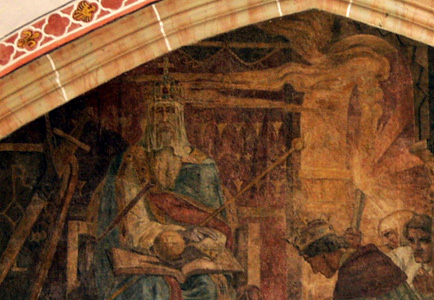
Charlemagne was co-opted for the projection of ideas and ideologies
In 1847, Alfred Rethel painted a Charlemagne whose face is blurred by a veil. The painting is based on a medieval description of the opening of Charlemagne's tomb by Emperor Otto III. But it is also a symbol of how the features of the historical Charlemagne have long disappeared behind a veil of later interpretations and reinterpretations. Each passing century has interpreted Charlemagne in its own interests: as a model ruler and as a saint, as a guarantor for prosperity and stability, as a Frenchman or as a German.
In the 20th century, the National Socialists misappropriated the memory of Charlemagne for their own purposes. At first, the regime used him as the stereotype of the enemy. It depicted him as the "Saxon slayer" and contrasted him with the Saxon leader Widukind as a Germanic symbolic figure. During the Second World War, this depiction lost its relevance. The Nazi propaganda machine reinterpreted Charlemagne as Hitler's forerunner, and his empire as an early form of a Europe "newly ordered" by the National Socialists. One unit of the Waffen-SS bore the name "Division Charlemagne". The intention was to mobilise French volunteers for the German war of extermination in Eastern Europe.
Alfred Rethel, fresco, 1847
Aachen Town Hall, Coronation Hall


